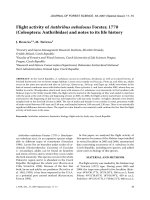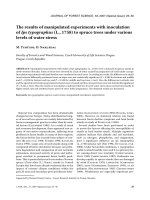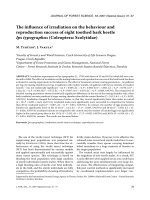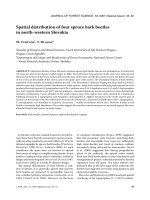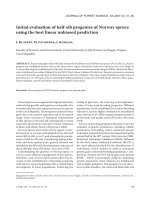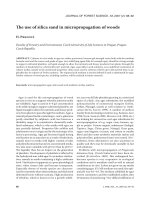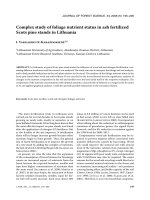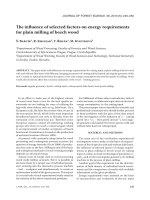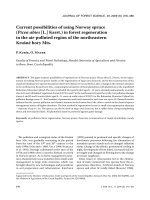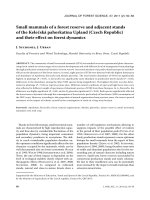Báo cáo lâm nghiệp: "Effects of resource availability on condensed tannins and nitrogen in two Quercus species differing in leaf life span" doc
Bạn đang xem bản rút gọn của tài liệu. Xem và tải ngay bản đầy đủ của tài liệu tại đây (162.34 KB, 7 trang )
Ann. For. Sci. 64 (2007) 439–445 Available online at:
c
INRA, EDP Sciences, 2007 www.afs-journal.org
DOI: 10.1051/forest:2007021
Original article
Effects of resource availability on condensed tannins and nitrogen
in two Quercus species differing in leaf life span
Marc E
a
*
, Montserrat D
C
b
,JosepMariaE
b
a
Unitat d’Ecofisiologia CSIC-CEAB-CREAF, CREAF (Centre de Recerca Ecològica i Aplicacions Forestals), Universitat Autònoma de Barcelona,
08193 Bellaterra, Catalonia, Spain
b
Centre de Recerca Ecològica i Aplicacions Forestals (CREAF), Universitat Autònoma de Barcelona, 08193 Bellaterra, Catalonia, Spain
(Received 2 June 2006; accepted 8 November 2006)
Abstract – Seedlings of Quercus ilex and Q. cerrioides, an evergreen and a winter-deciduous oak co-occurring in western-Mediterranean forests, were
grown at two lightregimes (8 and 36% of photosynthetically active radiation), at two water regimes (500 and 800 mm) and with two nutrient availabilities
(standard substrate and 7% increase in soil N). The concentrations of soluble condensed tannins (CT) and nitrogen in the leaves were analyzed to test
the phenotypic plasticity of these commonly related parameters in two con-generic species with contrasting leaf habit. Q. ilex contains seven times
more CT and a few less N than Q. cerrioides. Light increased CT, whereas neither fertilization nor water had an effect on CT. N concentration was
decreased by light, increased by fertilization and not affected by water treatment. Plant growth was increased by light but not affected by fertilization
or water treatment. CT were negatively correlated with N concentration. CT of the evergreen species exhibited greater plasticity than the deciduous
one as reflected by a steeper negative correlation among nitrogen and CT concentrations in Q. ilex. Given the antiherbivory activity of CT, this implies
that in less shaded environments, e.g. canopy aperture by disturbances, leaf tissue quality for herbivores will be much more reduced in Q. ilex than in
Q. cerrioides. Higher leaf CT in Q. ilex and its higher plasticity to light availability may explain the higher browsing by sheep in Q. cerrioides than in
Q. ilex resprouts, as well as the low recruitment rates of seedlings of the former species, reported in other studies.
condensed tannins / deciduous / evergreen / Quercus ilex / Quercus cerrioides / herbivory
Résumé – Effets de la disponibilité de la ressource sur les tanins condensés et l’azote chez deux espèces de Quercus différ entes pour la durée de
vie de leurs feuilles. Des semis de Quercus ilex et Quercus cerrioides, une espèce sempervirente et une espèce décidue co-existantes dans les forêts
méditerranéennes occidentales, ont été élevés sous deux régimes lumineux (8 et 36 % de PAR), deux régimes d’alimentation hydrique (500 et 800 mm)
et avec deux niveaux d’alimentation nutritionnelle (substrat standard et substrat avec une augmentation d’azote de 7 %). Les concentrations des tanins
solubles condensés (CT) et d’azote des feuilles ont été analysées pour tester la plasticité phénotypique de ces paramètres couramment rapportés chez
deux espèces de même genre ayant des types différents de feuilles. Quercus ilex contient 7 fois plus de CT et un peu moins d’azote que Quercus
cerrioides. La lumière accroît CT alors que ni la fertilisation ni l’eau ont eu un effet sur CT. La concentration en azote a diminué avec l’augmentation de
la lumière, elle a été augmentée par la fertilisation et n’a pas été affectée par le niveau d’alimentation hydrique. La croissance des semis a été augmentée
par l’augmentation du PAR mais n’a pas été affectée par la fertilisation ou le niveau d’alimentation en eau. CT a été corrélée avec la concentration
en azote. La CT des espèces sempervirentes présente une plus grande plasticité que les espèces décidues comme cela est reflété par une plus forte
corrélation négative entre les concentrations d’azote et de CT chez Quercus ilex. Etant donné l’activité antiherbivore de CT, cela implique que dans les
environnements moins ombragés, par exemple dans les ouvertures de la canopée, la qualité des tissus foliaires sera plus diminuée chez Quercus ilex, que
chez Quercus cerrioides. Une CT plus élevée chez Quercus ilex, et sa plasticité plus grande à la lumière peuvent expliquer un broutage plus important
des rejets par les moutons chez Quercus cerrioides que chez Quercus ilex, de même que le faible taux de recrutement de semis de la première espèce
qui est rapportée dans d’autres études.
tanins condensés / décidu / sempervirent / Quercus ilex / Quercus cerrioides / herbivor e
1. INTRODUCTION
Condensed tannins (CT) are secondary compounds of
polyphenolic nature derived from phenylpropanoid precur-
sors. They occur in the leaves of all ferns and gymnosperms
and about half the families, the woody members, of an-
giosperms [23]. CT are considered plant chemical defenses
against pathogens and herbivores [6]. Antiherbivory activity
is based on its negative effects on palatability and digestibility
due to its ability to bind to proteins [42].
* Corresponding author:
CT, as well as other phenolic compounds, are carbon-
based secondary compounds because they do not contain ni-
trogen atoms. The concentration of carbon-based secondary
compounds has been related to the availability of resources
both from an evolutionary [15] and from a phenotypic point
of view [7, 24, 34]. From a phenotypic point of view, the
Carbon Nutrient Balance [7] hypothesis relates carbon-based
secondary compounds concentration to the balance between
carbon and nitrogen in the plant and predicts that plants allo-
cate more carbon to carbon-based secondary compounds when
carbon accumulates in excess of growth demands (i.e. under
nutrient deficiency, high light and elevated CO
2
). Similarly,
Article published by EDP Sciences and available at or />440 M. Estiarte et al.
the Growth Differentiation Balance hypothesis [24] extends
the carbon nutrient balance hypothesis, and considers that
any environmental condition that affects photosynthesis (car-
bon source) and growth (carbon sink) with different inten-
sity will affect the relative carbon pool available for allocation
to carbon-based compounds. According to growth differenti-
ation balance hypothesis, conditions that limit growth more
than photosynthesis, such as nutrient limitation or moderate
drought, increase the carbon available for allocation to carbon-
based secondary compounds.
Koricheva et al. [28] conducted a meta-analysis of
147 species to test the carbon nutrient balance and growth dif-
ferentiation balance hypothesis and concluded that plant re-
sponses to nitrogen fertilization and shading were consistent
with the predictions of both hypotheses in terms of pooled
carbon-based secondary compounds, but among biosyntheti-
cally distinct groups of carbon-based secondary compounds,
only concentrations of phenylpropanoid-derived compounds,
such as CT, changed as predicted, as was also described in
Peñuelas and Estiarte’s [34] review.
Quercus ilex and Q. cerrioides – a species from the Quer-
cus humilis group with several probable introgressions from
other deciduous Quercus – are two very abundant oaks in
the western rim of the Mediterranean Basin. Mediterranean
ecosystems are characterized by the variability in resources
availability (water, nutrients and light). The Mediterranean
climate is characterized by dry and warm summers and
by a high interannual variability in precipitation. The soils
in Mediterranean ecosystems have low nutrient availability
which limits plant growth [41, 43]. The heterogeneity in
Mediterranean ecosystems overlaps with a high frequency of
disturbances. Fire and herbivory, as two of the main distur-
bances in the Mediterranean-Basin, play a crucial role in de-
termining an heterogeneous structure of Mediterranean-type
communities [36]. Consequently, the amount of light available
in forest understory can vary greatly due to the different degree
of canopy closure depending on forest cover and canopy struc-
ture [47].
Specific plant response to environmental heterogeneity
plays a key role in the coexistence or substitution among forest
tree species. Plants adjust their architecture, physiology and
biomass distribution in order to acquire the limiting resources
such as light, water and nutrients. However, species differ in
the degree of phenotypic plasticity. Regarding light intensity
heterogeneity, species can be classified as “shadow tolerant” if
they can regenerate under forest canopy, and “shadow intoler-
ant” if they cannot maintain a seedling bank under such condi-
tions [11, 17]. On the other hand, Mediterranean species have
developed several mechanisms of tolerance to water stress and
low nutrient availability. Within this framework of resources
variability, plasticity of antiherbivore defenses may play an
important role for plant survival, especially during the juve-
nile period (seedling stage).
Q. ilex and Q. cerrioides have similar properties: slow
growth, deep roots, resprouting ability after disturbances, but
differ in leaf duration: Q. cerrioides is a winter-deciduous and
Q. ilex is an evergreen. Differences in leaf life span may im-
ply differences in the use of light, water and nutrients. Ever-
greenness has been considered as an adaptation to nutrient and
water poor environments [5], whereas deciduousness implies
a shorter photosynthetically active period that must be com-
pensated by a high light-saturated assimilation rate, which re-
quires large nutrient and water availabilities [18].
We aim to study the phenotypic plasticity of CT depending
on the availability of several abiotic resources (light, nutrients
and water) in order to establish their influence on chemical de-
fense against herbivores on two Quercus species contrasting in
leaf life span. The three different resources vary in the natural
environments where these species grow: light depending on
canopy closure, nutrients depending on soil fertility and water
subject to inter-year natural variation.
2. MATERIAL AND METHODS
2.1. Experimental design
Acorns of Q. ilex and Q. cerrioides were set under optimal condi-
tions to promote germination and, once germinated, were transferred
to individual plastic pots filled with 1.5 L of oligotrophic substra-
tum (TKS1, Floragard Vertrieb GmbH, Oldenburg, Germany). Pots
were placed outdoors in a garden of the Autonomous University of
Barcelona under a transparent plastic roof 6 m high, providing al-
most natural atmospheric conditions but excluding rainfall. Recent
emerged seedlings were assigned to different light, nutrients and wa-
tering treatments factorially combined. Each combination of light,
water and nutrients availability included 21 seedlings per species and
was repeated in three replications (three separate blocks, see [20] for
further details on this experiment). For the light treatment the photo-
synthetic active radiation (PAR) was reduced by suspending a shade
cloth to 8% of the naturally incident PAR for the low-light environ-
ment (L8) and to 36% of the incident PAR for the high light envi-
ronment (L36), in order to reproduce the light environment of Quer-
cus forests with low (L36) and high (L8) canopy cover [19]. Plants
were watered every two weeks at two regimes, a low regime (W500 =
500 mm y
−1
) and a high water regime (W800 = 800 mm y
−1
). High
and low water regimes are above and below the yearly average precip-
itation of 600 mm m
−2
y
−1
that is registered on the distribution area
of both species. To provide realistic conditions, the annual amount
of water was distributed monthly following the Mediterranean sea-
sonal pattern, characterized by a rainy spring and fall and a dry sum-
mer. The fertilization treatment consisted of a low nutrient level (N−)
for the plants growing in the non-amended oligotrophic substrate,
whereas for the high nutrient level (N+) the substrate was supplied
at the beginning of the experiment with 48 kg N ha
−1
,19kgPha
−1
and58kgKha
−1
.
At the end of the experiment, 12 Q. ilex and 12 Q. cerrioides
seedlings of each treatment were randomly chosen (four per repli-
cation) and total biomass was separated into leaves, stems and roots.
Dry weight of roots, shoots, and leaves was calculated after drying at
60
◦
C (72 h) and total plant biomass was considered as an estimate
of the net growth of seedlings. For the two species, leaves of the four
seedlings harvested for each treatment and replication were pooled to
obtain an amount sufficient for grinding and analyzing.
Condensed tannins in evergreen and deciduous Quercus 441
Tabl e I. Results of ANOVA analysis for the effects of light, water and species on leaf CT, N and growth under a fixed level of nutrients (N–).
The sources of variation were light levels (L8, L36), water levels (W500, W800) and species (Q. ilex, Q. cerrioides)(df = degrees of freedom).
Condensed Tannins Nitrogen Growth
Source of variation df F value P value F value P value F value P value
Light 1 23.5 0.0002 283.53 0.0001 56.5 0.0003
Water 1 0.6 0.8088 3.50 0.0810 9.5 0.1014
Species 1 77.1 < 0.0001 31.50 0.0001 0.4 0.5556
Light × Water 1 0.5 0.4823 4.28 0.0564 0.2 0.6712
Light × Species 1 16.4 0.0011 6.06 0.0264 2.5 0.1611
Water × Species 1 0.0 0.8879 0.79 0.3895 0.4 0.5721
Light × Water × Species 1 0.2 0.6358 2.18 0.1604 0.8 0.4069
2.2. Chemical analyses
Soluble CT were extracted from 20 mg of leaf powder with
70% acetone. Tubes containing the sample and the acetone were
sonicated three times for 1 min allowing the tubes to cool for three
minutes between successive sonications. After centrifugation, the ex-
tract was assayed with the butanol/HCl method [35] modified as
in [30]. Briefly, 0.5 mL of the extract were mixed with 3 mL butanol-
HCl (95:5) and 0.1 mL of ferric reagent (ferric ammonium sulfate in
2 N HCl) and maintained in a boiling bath for 60 min. The absorbance
was read at 550 nm after cooling the tube. Non-heated replicate
tubes for each extract were used as anthocyanin blank by substract-
ing its absorbance from the absorbance of the heated tubes. The CT
content on a dry weight basis was estimated using an E
1%,1cm, 550nm
of 460 [30, 35]. CT analyses were done in duplicate. Nitrogen con-
centrations were determined in an elemental analyzer (Carlo Erba In-
struments EA 1108 CHNS/O, Milan, Italy).
2.3. Statistics
During the experiment a high rate of seedling mortality was ob-
served for the low water-high nutrient combination (see [20]). This
situation lead to the original experimental design becoming unbal-
anced. For this reason, statistical analyses to asses the effects of wa-
tering and nutrients were performed independently. Nutrient treat-
ment effects were assessed on the W800 water regime using a three
way ANOVA with species, light and nutrients as fixed factors. Wa-
ter treatment was assessed only for the low nutrient treatment with
species, light and water as fixed factors. Differences among levels of
each main factor were tested by Fisher’s PLSD.
3. RESULTS
Leaf CT concentrations were significantly higher
(ca 7 times) in Q. ilex than in Q. cerrioides (Tab. I,
Fig. 1A). Neither water nor nutrient treatment had an effect on
CT (Tabs. I and II), whereas light enhanced CT concentrations
in the two species (Tabs. I and II). However, the interaction
light × species (Tab. I, Fig. 1A) revealed that this increase was
larger in Q. ilex (146%) than in Q. cerrioides (57%).
Conversely to leaf CT concentration, N concentrations were
higher (1.15 times) in Q. cerrioides than in Q. ilex. N concen-
tration significantly varied with nutrient and light availability
Figure 1. Mean (% ± SE) CT concentration (A), N concentration (B)
and growth (C) for Q. ilex and Q. cerrioides in the two light levels
tested (low light-L8 and high light-L36) under low nutrient treatment
(n = 6). Growth is expressed as final weight (gr plant) of plants grown
from seeds.
442 M. Estiarte et al.
Table II. Results of ANOVA analysis for the effects of light, nutrients and species on leaf CT, N and growth under a fixed level of water (W800).
The sources of variation are light levels (L8, L36), nutrient levels (N−,N+) and species (Q. ilex, Q. cerrioides)(df = degrees of freedom).
Condensed Tannins Nitrogen Growth
Source of variation df F value P value F value P value F value P value
Light 1 26.25 0.0001 188.91 0.0001 10.3 0.0266
Nutrients 1 0.0 0.9492 6.69 0.0199 1.2 0.2839
Species 1 227.0 < 0.0001 5.35 0.0343 0.8 0.3917
Light × Nutrients 1 0.6 0.4305 0.46 0.5060 0.3 0.7760
Light × Species 1 7.5 0.0146 1.50 0.2384 1.3 0.3052
Nutrient × Species 1 0.1 0.8124 0.91 0.3550 2.2 0.1659
Light × Nutrient × Species 1 1.8 0.2024 2.24 0.1539 1.9 0.1916
Figure 2. CT concentration as a function of N concentration in leaves
of Q. ilex (solid circle) and Q. cerrioides (open circle). Data for differ-
ent treatments were pooled. The regression equations were: for Q. ilex
%CT = 5.229 – 1.952 * %N; R
2
= .502, P = 0.0003), and for Q. cer-
rioides %CT = 0.944 – 0.335 * %N; R
2
= 0.352, P = 0.0058).
(Tabs. I and II). Seedlings grown under the low nutrient level
had a lower leaf N concentration than those of the high nutrient
level (respectively, N = 1.38 ± 0.13% vs. N = 1.54 ± 0.14%).
In the two species, light decreased N concentrations with a
larger reduction in Q. ilex (99%) than in Q. cerrioides (57%)
(Fig. 1B).
Growth, measured as final biomass of plants grown from
seeds, did not differ between Q. ilex and Q. cerrioides at the
end of the experiment (Q. ilex = 7.0±0.6gandQ. cerrioides =
7.3 ± 0.9 g). In both species growth was enhanced by light
availability (Tabs. I and II, Fig. 1C), whereas it was affected
neither by nutrient nor water availability (Tabs. I and II).
CT were negatively correlated with N concentration (Fig. 2)
for both species. The relation was steepest for Q. ilex,asre-
flected by light × species interaction (Tabs. I and II), indicat-
ing that this evergreen species with higher concentration has
more phenotypic plasticity in carbon allocation to CT.
4. DISCUSSION
Average leaf concentrations of CT measured in Q. ilex
(2.8%) are lower than the values reported for the species
(2% [9], 3.6−8.1% [10], 8.7% [37]), partly because they were
measured under low or moderate light availability, but higher
than the low amounts reported in other studies (0.5% [31]).
The lower leaf CT in Q. cerrioides were at the low range of
concentrations found among Quercus species [32]. Whereas
we found higher CT in the evergreen species, other au-
thors did not find any difference in another pair of co-
occurring evergreen and deciduous oaks, such as Q. ilex and
Q. pubescens [45].
The difference in N concentrations between Q. cerrioides
and Q. ilex was small, only 1.15 times more in the decidu-
ous than in the evergreen species, but when taking into ac-
count only the 36% PAR ligh level, Q. cerrioides N concen-
trations were 1.41 times higher. This difference has also been
described for other pairs of co-occurring evergreen and decid-
uous oak species: Q. pubescens had 1.6 times more N than
Q. ilex [16, 45], and the deciduous Q. faginea had 1.6 times
more N than the evergreens Q. ilex and Q. coccifera [13].
The leaf chemistry reflects how plants with longer leaf life-
times invest more resources to better defend leaves that are
more exposed to herbivore attack [15]. Species with longer
leaf lifetimes tend to be sclerophyllus, and have lower SLA
and leaf N to maximize unpalability [2, 18], as in the case of
the pair of oaks we studied.
We expected higher CT concentrations under high light be-
cause higher photosynthesis, and consequently carbon sup-
ply, reduces C/N ratio (carbon nutrient balance hypothesis)
or either because, although growth is also stimulated, light
promotes a stronger stimulation on carbon acquisition by pho-
tostynthesis than on carbon demand for growth (growth dif-
ferentiation balance hypothesis), and more carbon is available
for allocation to CT. The two species studied had the pre-
dicted response to light in agreement with the meta-analysis
of Koricheva et al. [28] and the review of Peñuelas and
Estiarte [34]. Light availability is, thus, confirmed as a very
strong determinant of CT concentrations.
Condensed tannins in evergreen and deciduous Quercus 443
We expected lower CT concentrations increasing nutrient
availability because of an increase in N concentration, and a
decrease in C/N ratio (carbon nutrient balance hypothesis),
parallel to an increase in carbon demand for growth higher
than the positive effects of better nutrition on photosynthetic
carbon acquisition (growth differentiation balance hypothe-
sis). Decreases in phenolics with nutrient availability were
found in the meta-analysis of Koricheva et al. [28] and the re-
view of Peñuelas and Estiarte [34]. However, the lack of effects
on CT of the fertilization treatment reported in our study dis-
agrees with these predictions. Some Quercus have also shown
results in disagreement with these expectations, such as the
lack of effect of N fertilization reported for Q. rubra leaf
CT [27], but others have been reported to increase leaf N and
decrease CT in response to soil fertilization, as was the case of
Q. coccifera [22].
Although leaf N reduction by increasing light availabil-
ities has often been considered as a consequence of dilu-
tion by more carbon fixed, surprisingly the meta-analysis by
Koricheva et al. [28] concluded that there was an absence of
light effects on leaf N. Koricheva’s conclusion was based on
21 observations. Further revisions are needed to reconsider
this conclusion, which contradicts general considerations on
the basis of ecological stoichiometry (see [44]) and the effect
of light found for both Quercus species. In contrast with CT,
where no effect of nutrient treatment was found, higher N con-
centrations were found in leaves at high N treatment, a result
which rules out the absence of effect of a mild level of fertilizer
(7% increase in soil N availability) on leaf chemistry. How-
ever, the effects of nutrient treatment were restricted to leaf
N concentration because growth was not affected by fertiliza-
tion (Tab. II). Similarly, neither several morphological param-
eters [14,20], nor, as mentioned, were CT affected (Tab. II).
Horner [26] proposed a non-linear effect of water deficit on
carbon-based secondary compounds depending on the inten-
sity of the deficit. Moderate water deficits, causing a stronger
decline in growth than in photosynthesis, will result in car-
bon accumulation that can be allocated to carbon-based sec-
ondary compounds, whereas severe deficits with stronger ef-
fects on photosynthesis than growth will reduce carbon-based
secondary compounds. Consequently, no clear pattern can be
found when experiments do not include a wide range of water
stress. Similarly to our results, Koricheva’s meta-analysis [28]
resultedinnoeffects of water deficit on carbon-based sec-
ondary compounds nor in N. Bussotti et al. [9] also found
no differences in leaf CT among Q. ilex stands growing in
sites with contrasting water availability, and a lack of rela-
tion among water availability and leaf N has also been de-
scribed for Q. ilex and Q. faginea along a rainfall gradient,
but at the humid extreme of the gradient Q. coccifera had
more leaf N [13]. Moreover, contrasting results have been de-
scribed at the individual level in Ceratonia siliqua seedlings,
a Mediterranean evergreen, where water stress increased CT
and reduced N in young leaves, but no effects were found in
old leaves [29]. Differences in intensity of effects among or-
gans were also described for Lotus corniculatus where water
stress reduced CT, but the reduction was more obvious in roots
than in leaves [12].
The carbon nutrient balance hypothesis [9], which relates
the concentration of carbon-based secondary compounds to
the balance between carbon and N is supported by the neg-
ative correlation we found between N and CT (Fig. 2). In our
experiment the relation was mainly driven by light and was
not found within plants of the same light level, probably due
to the mild level of fertilizer applied, but the same relation
has been found in other experiments that span a wider range
of fertilization levels [8]. The light treatment at 36% PAR is
the value below which growth of Q. ilex is limited by light,
and above which it is limited by water stress in a large part of
the area of distribution of the species [38]. Growth of Q. ilex
is not limited by carbon supply at this light intensity and ex-
cess carbon can be invested in secondary compounds without
diverting resources from growth. On the other hand, Q. cer-
rioides exhibited greater plasticity in response to light inten-
sity in morphological characteristics, e.g. root/shoot [20], but
not in growth (Tabs. I and II), whereas Q. ile x exhibited greater
plasticity in leaf CT. Our results seem to point to there being
a trade-off between morphologic plasticity and CT plasticity,
because whereas Q. cerrioides favours allocation to roots for
nutrient and water acquisition, Q. ilex increases leaf protection
by increasing leaf CT. The lack of effects of nutrient treatment
on growth and CT does not allow the trade-off between growth
and differentiation to be tested besides the evidence that in-
creases in carbon acquisition at high light increase the carbon
allocation to both biomass and CT.
In forests, perturbations that open the canopy and modify
the light environment can modify foliar chemistry and, conse-
quently, effect herbivore performance. Different studies have
outlined the importance of environmental conditions to finally
determine herbivory intensity [25, 46]. Although we did not
find effects of fertilization treatments besides leaf N, it is likely
that perturbations that modify nutrient availability, such as for-
est fires, can potentially modify leaf chemistry and affect her-
bivore performance. However, published results have failed
to show such effects: Rieske [39] has shown increased N in
Q. prinus seedlings growing after wildfire, but no changes in
CT were detected, Rieske et al. [6, 40] described no effects of
prescribed fire on CT of canopy leaves of Q. prinus and Q.
coccinea, and Adams and Rieske [1] reported that prescribed
fire history affected neither N nor CT in Q. alba seedlings, al-
though there was between year variation in both parameters
that authors attributed to drought. Such changes in leaf chem-
istry after forest fires are likely to affect plant-herbivore inter-
actions.
The importance of CT in plant-herbivore interactions has
been well established in studies involving woody species and
small ruminants widely distributed in the Mediterranean re-
gion [42], and has been tested for Q. ilex [33]. The intake of
some Mediterranean shrubs and trees, such are Q. calliprinos,
Pistacia lentiscus and C. siliqua, is limited by its high tannin
content [43]. However, the tolerance of herbivores to tannins
is species-specific: some species (e.g. sheep) are more sen-
sitive than others, which may even derive some benefit from
high tannin diets (e.g. goats) [33]. Moderate concentrations
(2−4%) of CT exert some beneficial effects on sheep nutri-
tion, whereas diets with high concentrations (6−12%) depress
444 M. Estiarte et al.
voluntary feed intake, digestive efficiency and animal produc-
tivity [3]. Q. ilex plants growing at 36% PAR had concentra-
tions of ca 4%, at the edge of concentrations with negative
effects on nutrition, but CT in Q. cerrioides were far from that
point. Moreover, the decrease in nutritional quality of leaves
grown under high light is amplified because the effects on
CT are opposite to the effects on N, and foliage quality de-
pends on benefits (e.g. nitrogen acquisition) and costs (e.g.
plant defenses ingestion) for the herbivore [4]. Consequently,
disturbances that open the canopy and promote less shaded
environments, including herbivory itself, cause an increase in
CT concentration that can negatively affect the nutrition of the
more sensitive species.
Espelta et al. [21] reported that sheep ate more post-fire
resprouts of Q. cerrioides than resprouts of Q. ilex, which
can be attributed to the higher CT in the evergreen species.
Furthermore, although under controlled conditions survival of
seedlings at 36% PAR was the same for both species and
survival at 8% PAR was higher for Q. cerrioides than for
Q. ilex [20], field observations in mixed forests of these species
commonly show a higher abundance of Q. ilex than Q. cer-
rioides seedlings [14]. We hypothesize that this fact can be
due to higher herbivorism in Q. cerrioides, facilitated by its
lower CT content and by its lower CT phenotypic plasticity
to light availability, an hypothesis that must be confirmed by
further studies.
Acknowledgements: We greatfully acknowledge funding from the
INTERREG III A project (I3A-1-100-E), Patronat Metropolità
del Parc de Collserola, Spanish Government grants REN2003-
04871/GLO, Catalan government grant SGR2005-00312, the EC
Integrated FP6 ALARM (GOCE-CT-2003-506675) Project, and a
Fundación BBVA 2004 grant. Marc Estiarte acknowledges finan-
cial support from the Spanish Ministerio de Educación y Ciencia
(Ramon y Cajal contract).
REFERENCES
[1] Adams A.S., Rieske L.K., Prescribed fire affects white oak
seedling phytochemistry: implications for insect herbivory, For.
Ecol. Manage. 176 (2003) 37−47.
[2] Aerts R., The advantages of being evergreen, Trends Ecol. Evol. 10
(1995), 402−407.
[3] Aerts R.J., Barry T.N., McNaab W.C., Polyphenols and agriculture:
beneficial effects of proanthocyanidins in forages, Agric. Ecosyst.
Environ. 75 (1999) 1−12.
[4] Belovsky G.E., Schmitz O.J., Mammalian herbivore optimal for-
aging and the role of plant defenses, in: Palo R.T., Robbins C.T.
(Eds.), Plant defenses against mammalian herbivory, CRC, Boca
Raton, 1991, pp. 1−28.
[5] Berendse F., Competition between plant populations at low and high
nutrient supplies, Oikos 71 (1994) 253−260.
[6] Bernays E.A., Cooper Driver G., Bilgener M., Herbivores and
plant tannins, in: Begon M., Fitter A.H., Ford E.D., MacFadyen A.
(Eds.), Advances in Ecological Research, Vol. 19. Academic Press,
London, 1989, pp. 263–302.
[7] Bryant J.P., Chapin III F.S., Klein D.R., Carbon/nutrient balance of
boreal plants in relation to vertebrate herbivory, Oikos 40 (1983)
357−368.
[8] Burns A.E., Gleadow R.M., Woodrow I.E., Light alters the alloca-
tion of nitrogen to cyanogenic glycosides in Eucalyptus cladocalyx,
Oecologia 133 (2002) 288−294.
[9] Bussotti F., Bettini D., Grossoni P., Mansuino S., Nibbi R., Soda C.,
Tani C., Structural and functional traits of Quercus ilex in response
to water availability, Environ. Exp. Bot. 47 (2002) 11−23.
[10] Cabiddu A., Decandia M., Sitzia M., Molle G., A note on chemi-
cal composition and tannin content of some Mediterranean shrubs
browsed by Sarda goats, Cah. Options Médit. 52 (2000) 175−178.
[11] Canham C.D., Different responses to gaps among shade-tolerant
tree species, Ecology 70 (1989) 548−550.
[12] Carter E.B., Theodorou M.K., Morris P., Responses of Lotus cornic-
ulatus to environmental change. 2. Effect of elevated CO
2
,temper-
ature and drought on tissue digestion in relation to condensed tan-
nin and carbohydrate accumulation, J. Sci. Food Agric. 79 (1999)
1431−1440.
[13] Castro-Díez P., Villar-Salvador P., Pérez-Rontomé C., Maestro-
Martínez M., Montserrat-Martí G., Leaf morphology and leaf chem-
ical composition in three Quercus (Fagaceae) species along a rain-
fall gradient in NE Spain, Trees 11 (1997) 127−134.
[14] Cortés, P., Distribución y dinámica de un Quercus caducifolio
(Q. cerrioides Wilk et Costa) y uno perennifolio (Q. ilex L.) en
Catalunya. Análisis de la ecología de la reproducción, la respuesta
de las plántulas a factores ambientales y la respuesta a las per-
turbaciones, M.Sc. thesis, Universitat Autònoma de Barcelona,
Barcelona, 2003.
[15] Coley P.D., Bryant J.P., Resource availability and plant antiherbi-
vore defense, Science 230 (1985) 895−899.
[16] Damesin C., Rambal S., Joffre R., Co-occurrence of trees with dif-
ferent leaf habit: a functional approach on Mediterranean oaks, Acta
Oecol. 19 (1998) 195−204.
[17] Denslow J., Tropical rainforest gaps and tree species diversity,
Annu. Rev. Ecol. Syst. 18 (1987) 431−451.
[18] Eamus D., Ecophysiological traits of deciduous and evergreen
woody species in the seasonally dry tropics, Trends Ecol. Evol. 14
(1999) 11−16.
[19] Espelta J.M., Riba M., Retana J., Patterns of seedling recruitment in
West Mediterranean Quercus ilex L. forests as influenced by canopy
development, J. Veg. Sci. 6 (1995) 645−672.
[20] Espelta J.M., Cortes P., Mangiron M., Retana J., Differences in
biomass partitioning, leaf nitrogen content, and water use effi-
ciency (delta C-13) result in similar performance of seedlings of
two Mediterranean oaks with contrasting leaf habit, Ecoscience 12
(2005) 447−454.
[21] Espelta J.M., Habrouk A., Retana J., Response to natural and sim-
ulated browsing of two Mediterranean oaks with contrasting leaf
habit after a wildfire, Ann. For. Sci. 63 (2006) 441–447.
[22] Glyphis J.P., Puttick G.M., Phenolics, nutrition and insect herbivory
in some garrigue and maquis plant species, Oecologia 78 (1989)
259−263.
[23] Harborne, J.B., Role of phenolic secondary metabolites in plants
and their degradation in nature, in: Cadisch G., Giller K.E. (Eds.),
Driven by nature. Plant litter quality and decomposition, CABI
Publishing, Oxon, 1999, pp. 67−74.
[24] Herms D.A., Mattson W.J., The dilemma of plants: to grow or de-
fend, Q. Rev. Biol. 67 (1992) 283−335.
[25] Heuze P., Schnitzler A., Klein F., Consequences of increased
deer browsing winter on silver fir and spruce regeneration in the
Southern Vosges mountains: Implications for forest management,
Ann. For. Sci. 62 (2005) 175−181.
Condensed tannins in evergreen and deciduous Quercus 445
[26] Horner J.D., Nonlinear effects of water deficits on foliar tannin con-
centration, Biochem. Syst. Ecol. 18 (1990) 211−213.
[27] Kinney K.K., Lindroth R.L., Jung S.M., Nordheim E.V., Effects of
CO
2
and NO
−
3
availability on deciduous trees: phytochemistry and
insect performance, Ecologia 78 (1997) 215−230.
[28] Koricheva J., Larsson S., Haukioja E., Keinänen M., Regulation
of woody plant secondary metabolism by resource availability:
hypothesis testing by means of meta-analysis, Oikos 83 (1998)
212−226.
[29] Kouki M., Manetas Y., Resource availability affects differentially
the levels of gallotannins and condensed tannins in Ceratonia sili-
qua, Biochem. Syst. Ecol. 30 (2002) 631−639.
[30] Makkar H.P.S., Goodchild A.V., Quantification of tannins: a labo-
ratory manual. International Center for Agricultural Research in the
Dry Areas (ICARDA), Aleppo, 1996.
[31] Makkar H.P.S., Dawra R.K., Singh S., Tannin levels in leaves of
some oak species at different stages of maturity, J. Sci. Food. Agric.
54 (1991) 513−519.
[32] Martin J.S., Martin M.M., Tannin assays in ecological studies: lack
of correlation between phenolics, proanthicyanidins and protein-
precipitating constituents in mature foliage of six oak species,
Oecologia 54 (1982) 205−211.
[33] Narjisse H., Elhonsali L.A., Olsen J.D., Effects of oak (Quercus
ilex) on digestion and nitrogen balance in sheep and goats, Small
Rumin. Res. 18 (1995) 201−206.
[34] Peñuelas J., Estiarte M., Can elevated CO
2
affect secondary
metabolism and ecosystem function? Trends Ecol. Evol. 13 (1998)
20−24.
[35] Porter L.J., Hrstich L.N., Chan B.G., The conversion of procyani-
dins and prodelphinidins to cyanidin and delphinidin, Phytochem.
25 (1986) 223−230.
[36] Quézel P., Médail F., Écologie et biogéographie des forêts du bassin
méditerranéen, Elsevier SAS, Paris, 2003.
[37] Rebolé A., Fiber and tannins of some agricultural and forest byprod-
ucts. Inclusion of these parameters in the prediction of in vitro di-
gestibility, J. Agric. Food Chem. 42 (1994) 739−743.
[38] Retana J., Espelta J.M., Gracia M., Riba M., Seedling recruitment,
in: Rodà F., Retana J., Gracia C.A., Bellot J. (Eds.), Ecology of
Mediterranean evergreen oak forests, Springer Verlag, Berlin, 1999,
pp. 89−101.
[39] Rieske L.K., Wildfire alters oak growth, foliar chemistry, and her-
bivory, For. Ecol. Manage. 168 (2002) 91−99.
[40] Rieske L.K., Housman H.H., Arthur M.A., Effects of prescribed fire
on canopy foliar chemistry and suitability for an insect herbivore,
For. Ecol. Manage. 160 (2002) 177−187.
[41] Sardans J., Rodà F., Peñuelas J., Phosphorus limitation and compet-
itive capacities of Pinus halepensis and Quercus ilex subsp. rotun-
difolia on different soils, Plant Ecol. 174 (2004) 305−317.
[42] Silanikove N., Gilboa N., Nir I., Perevolotsky A., Nitsan Z., Effect
of daily supplementation of polyethylene glycol on intake and di-
gestion of tannin-containing leaves (Quercus calliprinos, Pistacia
lentiscus and Ceratonia siliqua) by goats, J. Agric. Food Chem. 44
(1996) 199−205.
[43] Specht R.L., Structure and functional response of ecosystems in
the Mediterranean climate of Australia, in: Di Castri F., Mooney
H.A. (Eds.), Mediterranean-type ecosystems: Origen and structure,
Chapman & Hall, London, 1973, pp. 113−120.
[44] Sterner R.W., Elser J.J., Ecological Stoichiometry: The Biology of
Elements from Molecules to the Biosphere, Princeton University
Press, Princeton, 2002.
[45] Tognetti R., Johnson J.D., Michelozzi M., Raschi, A., Response
of foliar metabolism in mature trees of Quercus pubescens and
Quer cus ilex to long-term elevated CO
2
, Env. Exp. Bot. 39 (1998)
233−245.
[46] Vila B., Guibal F., Torre F., Martin J.L., Can we reconstruct deer
browsing history and how? Lessons from Gaultheria shallon Pursh,
Ann. For. Sci. 62 (2005) 153−162.
[47] Zavala M.A., Espelta J.M., Retana J., Constraints and trade-offsin
Mediterranean plant communities: The case of holm oak-Aleppo
pine forests, Bot. Rev. 66 (2000) 119−149.
